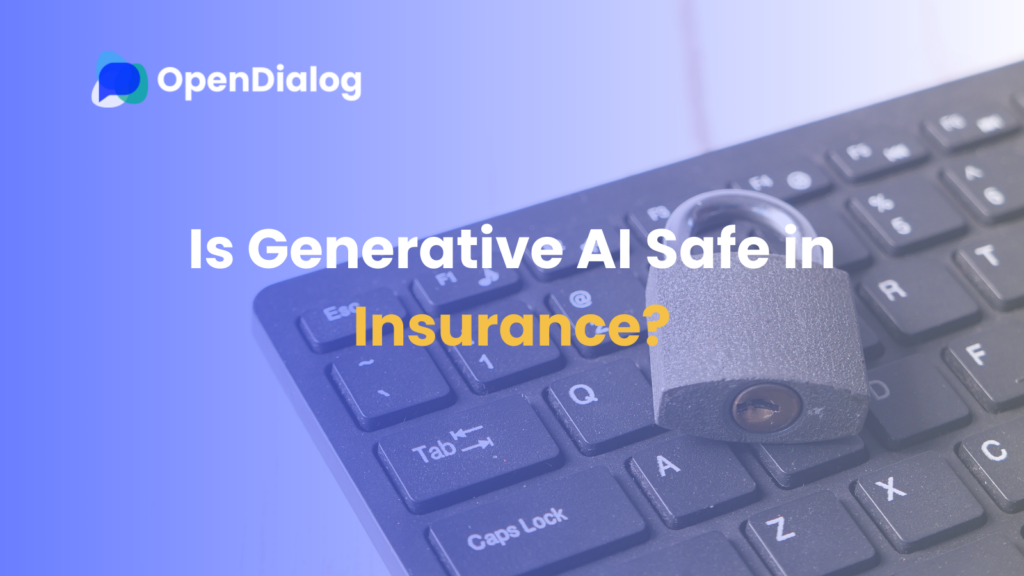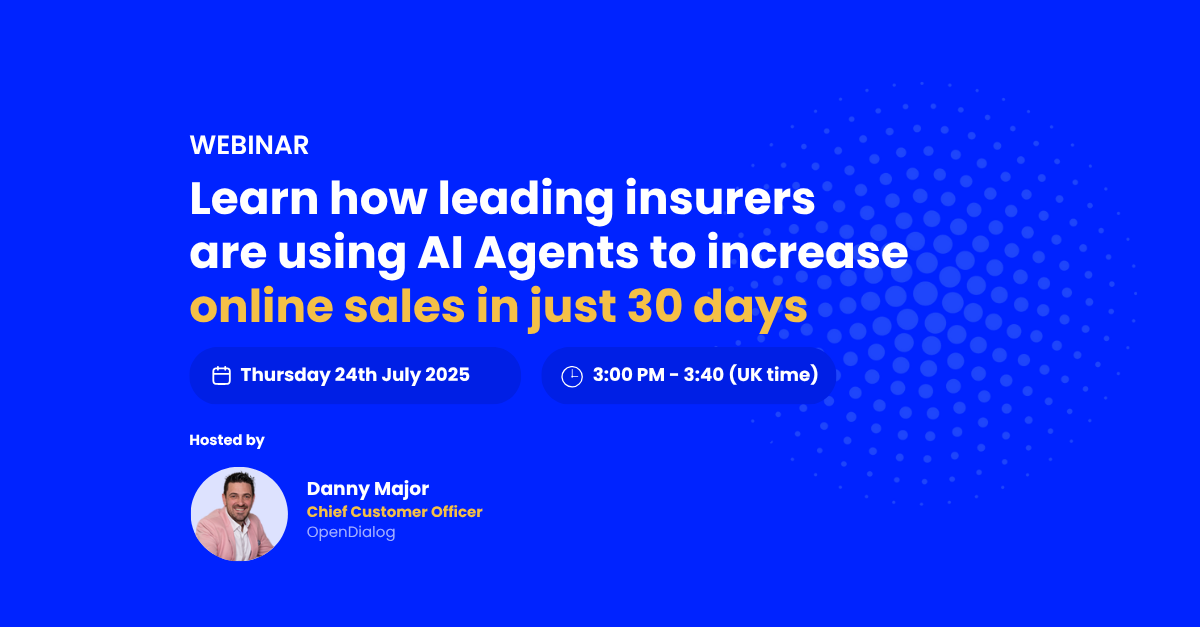The insurance industry, like many others, is rapidly adopting generative AI technologies like conversational AI, to enhance customer service, streamline processes, and improve overall efficiency through automation. In fact, it’s thought that insurance companies will likely save $1.3 billion globally by the end of the year by using AI-powered chatbots and digital assistants.
However, as companies undertake digital transformation for the generative AI age, questions about the technology’s safety, transparency, and accountability arise. In this article, we delve into key considerations surrounding the safety of generative and conversational artificial intelligence in insurance.
How does Generative AI meet compliance requirements?
Generative AI automation is big news for insurance providers. However, in an industry subject to stringent regulation, it’s essential that this efficiency-driving technology can stay on top of compliance.
Most out-of-the-box generative AI solutions don’t adhere to the strict regulations within the industry, making it unsafe for insurance companies to adopt such new technologies at scale, despite their advantages. With requirements to protect consumers and ensure fair practices, conversational AI systems that use generative AI must align with these regulations.
For generative AI solutions to meet compliance requirements and be considered trustworthy they must adhere to criteria such as explainability and accuracy, we explore these below.
Is Generative AI explainable?
One of the primary concerns with generative AI is its explainability. In the insurance industry, where decisions can have significant financial and legal implications, they need to be explainable to adhere to the industry’s regulatory standards. Thus, this is a crucial challenge to tackle when implementing generative AI automation in insurance.
First, let’s define what exactly we mean by this, more specifically what explainability in conversational AI means for insurers. In short, explainability refers to the ability to clarify the system’s decision-making process.
Many conversational AI systems use Large Language Models (LLMs) and other Natural Language Processing (NLP) capabilities to understand and respond to human inputs. LLMs such as GPT4 and Llama are trained on massive amounts of data. Although efforts to make their decision-making process more transparent are ongoing, these models remain black boxes with limited explainability and their output too unpredictable for out-of-the-box use, specifically in regulated industries such as insurance.
Most Conversational applications that utilize these advanced Generative AI models lack the control and explainability necessary for regulated industries so LLMs are usually substituted by structured decision trees, sacrificing natural, agile dialog for compliance.
OpenDialog offers a solution that provides a natural conversational experience for users while its context-first architecture works under the hood to analyze and add structure to fluid conversations.
This creates an auditable trail and enables full control over how multiple connected knowledge systems and language models are orchestrated, allowing regulated organizations to harness the full capabilities of generative AI automation that is safe for their users and adheres to compliance standards.
Confidence in Conversational AI
Insurance companies implementing generative and conversational AI need to be confident that the technology will generate responses that are aligned with business rules and mitigate the risk of running afoul of compliance. Understanding the decision-making process that leads up to the generated responses, as well as ensuring control over these outputs, is therefore essential during the building process, in the decision moment, and after the fact.
For Example…
Take this example of answering a responsibility question for a car accident using generative AI.
Let’s say a customer asks the following question: “I hit another car in the rear at a stop sign. Am I covered for this?” The conversational AI solution generates an outcome of: “Yes, generally this type of incident would be covered by your car insurance policy, specifically under the collision coverage or liability coverage that you have. Liability coverage would pay for damages to the other person’s vehicle or personal injuries if you’re at fault in an accident. However, specific coverages may vary depending on the details of your policy. I would advise you to review your policy or we can discuss it further to give you a proper understanding of what is covered.” As insurance professionals, you can easily spot the issues with this type of response, its compliance issues, and its potential impact on the claim settlement process.
Suppose insurance companies blindly adopt an LLM-based solution without any immediate guardrails or specific policy rules. In that case, they can not guarantee the LLM will not ‘by accident’ provide information contrary to policies, regulations, and compliance, or worse, becomes legally binding.
Therefore, companies adopting this technology need to be sure that the results and answers given are reliable, follow policy rules, and can transparently be explained, both in the moment and after the fact. They must be able to harness the outcomes so that regulations are respected and avoid any adverse outcomes.
The OpenDialog platform uses LLMs where relevant and combines this with rule-based processes appropriately. This gives organizations the ability to leverage LLMs to the best of their capacity, all while ensuring it’s in line with business policies, in turn protecting data-sensitive processes.
OpenDialog provides business-level event tracking and process choice explanation, giving our customers a clear audit path into what decisions were made at each step of the conversation their end-users have with their chatbot.
Ensuring that conversational AI systems are designed to provide explanations for their outputs is essential. This fosters trust among users and helps insurers comply with regulatory requirements. The European Parliament’s AI Act reinforces a commitment to ethical principles such as transparency, security, and justice.
Is Generative AI accurate?
Accuracy is crucial in insurance, as decisions are based on risk assessments and data analysis. Generative AI technology employed by conversational AI systems must be thoroughly tested and continuously monitored to ensure its accuracy. As generative AI is prone to hallucination (inaccurate or incorrect answers), it’s crucial that guardrails are created to avoid risk to the customer, and the company.
Insurers should also invest in robust testing protocols, incorporating real-world scenarios to validate the AI’s performance. Regular updates and maintenance are also essential to address evolving challenges and improve accuracy over time.
OpenDialog acts as the explainable business layer, hence reducing risk along the way. OpenDialog is uniquely built to reason over user input, incorporating conversation and business context before deciding whether to use a generated or a pre-approved response.
What are the privacy concerns around Generative AI?
60% of consumers have expressed concern about how organizations use and apply AI, suggesting that the majority of people don’t feel comfortable with how their data is being used. This is where transparency and safety are essential within machine learning technology. Users must trust the conversational AI solution they’re using.
The insurance sector handles sensitive personal information, making privacy a top concern. Conversational AI systems must be designed with robust privacy safeguards to protect customer data. With this in mind, users expect a level of usability with the technology they use and trust. Implementing AI without a clear User Experience (UX) strategy often leads to a disconnect between user expectations and the AI’s capabilities.
As well as this, tight encryption, secure data storage, and strict access controls are essential components of an effective conversational AI system. Insurers should prioritize privacy in both the design and implementation of their AI solutions.
How to avoid bias
AI systems can inadvertently perpetuate biases present in the data on which they are trained. In the insurance industry, this could lead to unfair discrimination.
Insurance companies should implement rigorous data screening processes to identify and eliminate biases. Ongoing monitoring and adjustments to the conversational model can help ensure fairness and equity in decision-making.
In addition, avoiding bias in the design of your Conversational AI solution is equally important. Be it in the choice of the tone of voice, level of understanding, use or not of jargon, adaptability of the interface to different audiences, or something as simple as the avatar you choose to represent the organization (if there is one).
It is a vast subject but the highlight is to leverage user-centric conversation design to complement AI models and make conscious decisions about eliminating bias.
Meeting financial standards
When using AI, insurance companies should conduct thorough audits to ensure that the technology meets regulatory standards. This includes adherence to data protection laws, fair treatment of customers, and compliance with industry-specific regulations. Or, with solutions such as OpenDialog’s generative AI automation platform that is specifically built for regulated industries, ensuring the safety of the end user.
Moreover, the Financial Conduct Authority (FCA) and the US Securities Exchange and Commission (SEC) regularly observe the rise in generative AI use across the industry and train staff to make sure it is used correctly and fairly.
In the UK, the FCA has also put in place specific frameworks to respond to innovations in AI, specifically around accountability, to address any issues that may come with AI adoption. While in the US, the SEC is closely monitoring the possibilities of generative AI use in heavily regulated industries and also putting policies in place to protect consumers.
Safely Using Generative AI in Insurance
Generative AI holds immense potential in the insurance industry, but addressing safety concerns is key. Through transparency, compliance, accuracy, accountability, and bias mitigation, insurers can responsibly unlock the transformative power of generative AI automation.
Learn more about how generative AI is changing the insurance industry.




